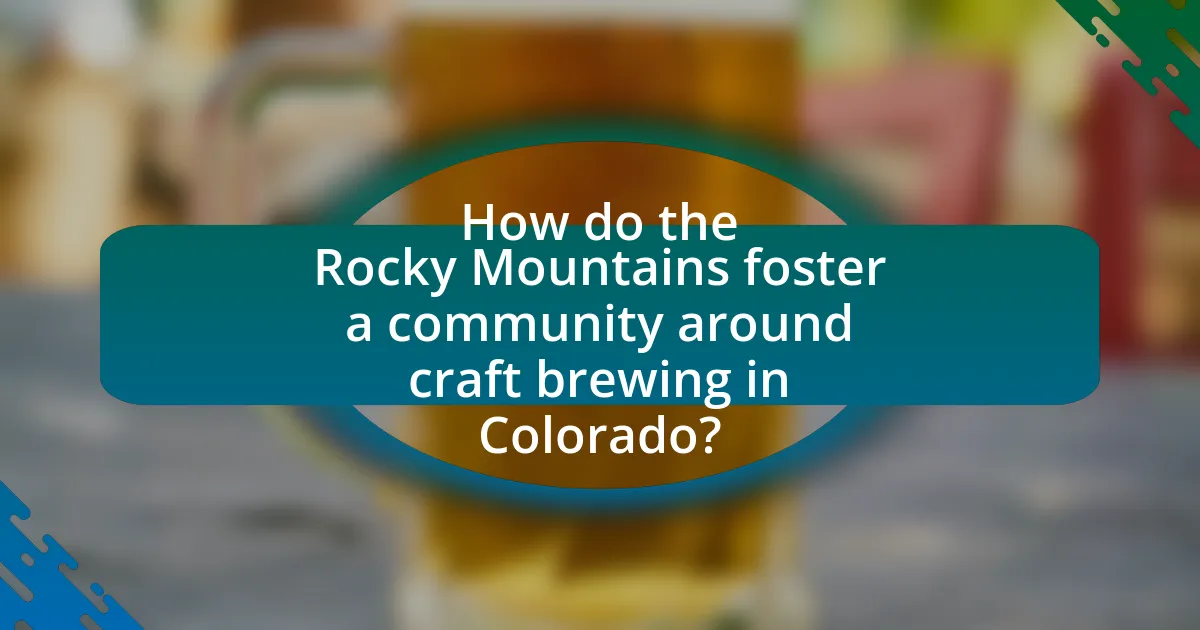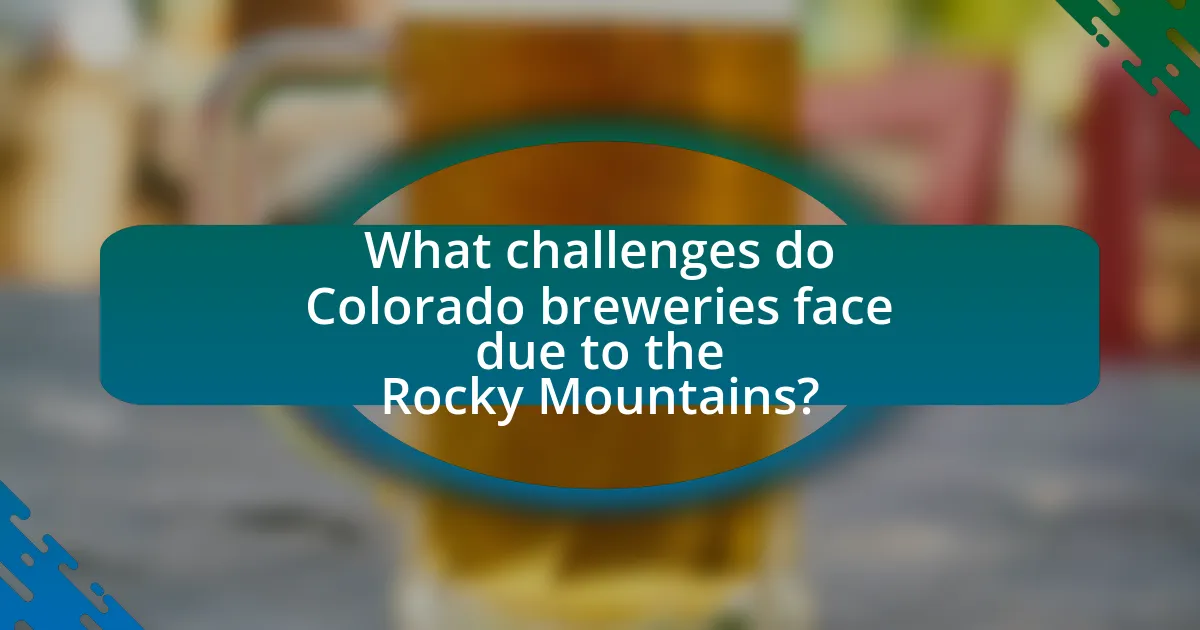The Rocky Mountains play a crucial role in shaping Colorado’s brewing culture by providing pure water sources essential for high-quality beer production. The region’s unique geographical features, including high elevation and natural filtration from snowmelt, contribute to the soft water ideal for brewing various beer styles. Additionally, the climate and local agriculture support the cultivation of unique ingredients, enhancing the diversity of craft beers. The article explores the historical development of Colorado’s brewing industry, the impact of local ingredients, and the community engagement fostered by breweries, while also addressing the challenges faced by breweries in mountainous environments.
What is the significance of the Rocky Mountains in Colorado’s brewing culture?
The Rocky Mountains significantly influence Colorado’s brewing culture by providing pure water sources essential for high-quality beer production. The mountains’ snowmelt feeds rivers and streams, creating a natural filtration system that results in soft water, ideal for brewing various beer styles. This unique water quality has been a key factor in the success of many Colorado breweries, such as Coors, which has utilized the region’s water for over 150 years. Additionally, the scenic backdrop of the Rockies attracts tourism, further enhancing the local craft beer scene and fostering a community that celebrates brewing traditions.
How have the Rocky Mountains influenced the brewing industry in Colorado?
The Rocky Mountains have significantly influenced the brewing industry in Colorado by providing a unique source of pure water essential for brewing. The high elevation and natural filtration of mountain snowmelt create water that is low in minerals, which is ideal for producing a variety of beer styles. This quality of water has been a critical factor in the success of many Colorado breweries, such as Coors, which was established in 1873 and has long emphasized the importance of its water source in its brewing process. Additionally, the mountainous terrain and climate contribute to a thriving local agriculture, supplying breweries with fresh ingredients like hops and barley, further enhancing the quality and diversity of Colorado’s craft beer offerings.
What geographical features of the Rocky Mountains impact brewing?
The geographical features of the Rocky Mountains, such as elevation, water sources, and climate, significantly impact brewing. The high elevation of the Rockies affects the boiling point of water, which can alter the brewing process and influence the extraction of flavors from ingredients. Additionally, the pristine water sources originating from mountain snowmelt provide high-quality water essential for brewing, as water quality directly affects the taste and character of beer. The region’s climate, characterized by temperature variations and seasonal changes, also influences the types of ingredients that can be grown locally, such as barley and hops, which are crucial for brewing. These features collectively shape the unique brewing culture in Colorado, fostering a diverse range of craft beers that reflect the local environment.
How does the climate of the Rocky Mountains affect beer production?
The climate of the Rocky Mountains significantly influences beer production by affecting the quality of water, temperature, and seasonal variations. The high elevation leads to cooler temperatures, which can enhance the brewing process by allowing for more controlled fermentation. Additionally, the snowmelt from the mountains provides pure, mineral-rich water essential for brewing, contributing to the unique flavor profiles of beers produced in the region. Studies have shown that the specific mineral content in Rocky Mountain water can enhance the taste and quality of various beer styles, making it a critical factor in Colorado’s brewing culture.
Why are the Rocky Mountains considered a unique brewing region?
The Rocky Mountains are considered a unique brewing region due to their high elevation, which influences water quality and temperature, essential factors in brewing. The mountains provide pure, mineral-rich water sourced from snowmelt, which is ideal for various beer styles. Additionally, the cooler climate at higher altitudes allows for slower fermentation processes, enhancing flavor complexity. The region’s diverse ecosystems contribute unique ingredients, such as local grains and hops, further distinguishing Rocky Mountain brews. These characteristics collectively create a distinctive brewing environment that attracts craft brewers and enthusiasts alike.
What historical events shaped the brewing culture in Colorado?
The brewing culture in Colorado was significantly shaped by the establishment of the state’s first breweries in the mid-19th century, particularly with the founding of the Colorado Brewery in 1859. This event marked the beginning of a local brewing tradition that grew alongside the influx of European immigrants, who brought their brewing techniques and styles. Additionally, the repeal of Prohibition in 1933 allowed breweries to reopen and thrive, leading to a resurgence in craft brewing. The 1970s saw the emergence of microbreweries, further diversifying the brewing landscape. These historical events collectively contributed to Colorado’s reputation as a hub for innovative and diverse beer production, supported by the state’s natural resources and the cultural influences of its residents.
How do local ingredients from the Rocky Mountains contribute to brewing?
Local ingredients from the Rocky Mountains significantly enhance brewing by providing unique flavors and characteristics that reflect the region’s terroir. The high-altitude environment contributes to the cultivation of distinct barley varieties and hops, which are essential for creating diverse beer profiles. For instance, the mineral-rich water sourced from mountain streams is known to influence the taste and mouthfeel of the beer, making it smoother and more refreshing. Additionally, local botanicals, such as wildflowers and herbs, are often incorporated into brews, adding complexity and a sense of place. This integration of regional ingredients not only supports local agriculture but also fosters a brewing culture that celebrates the unique identity of the Rocky Mountains.

How do the Rocky Mountains foster a community around craft brewing in Colorado?
The Rocky Mountains foster a community around craft brewing in Colorado by providing a unique environment that encourages local ingredients, tourism, and collaboration among brewers. The region’s high elevation and pure water sources contribute to the quality of the beer produced, while the scenic landscapes attract tourists who support local breweries. Additionally, the proximity of craft breweries to one another promotes a culture of collaboration, with many breweries participating in joint events and sharing resources, which strengthens the community. This interconnectedness is evidenced by the growth of the Colorado Brewers Guild, which represents over 400 craft breweries and fosters a sense of unity and shared purpose among them.
What role do local breweries play in the community?
Local breweries serve as vital community hubs, fostering social interaction and local culture. They contribute to the local economy by creating jobs, supporting local agriculture through sourcing ingredients, and attracting tourism. For instance, a study by the Brewers Association indicates that craft breweries generate over $76 billion in economic impact annually in the U.S., highlighting their significance in community development. Additionally, local breweries often engage in community events and charitable initiatives, further solidifying their role as integral parts of the social fabric.
How do breweries in Colorado collaborate with local farmers?
Breweries in Colorado collaborate with local farmers primarily by sourcing ingredients such as barley, hops, and other grains directly from them. This partnership not only supports local agriculture but also enhances the quality and uniqueness of the beer produced, as many breweries prioritize using locally grown ingredients to create distinct flavors that reflect the region’s terroir. For instance, the Colorado Malting Company supplies malt to various breweries, showcasing the direct link between local farming and brewing. Additionally, some breweries engage in community-supported agriculture (CSA) programs, allowing consumers to invest in local farms and receive products in return, further solidifying the connection between breweries and farmers.
What events and festivals celebrate Colorado’s brewing culture?
Colorado’s brewing culture is celebrated through various events and festivals, including the Great American Beer Festival, held annually in Denver, which showcases thousands of beers from hundreds of breweries. Another significant event is the Colorado Brewers’ Festival in Fort Collins, featuring local breweries and craft beer tastings. Additionally, the Denver Beer Fest, coinciding with the Great American Beer Festival, offers a week-long celebration of beer-related events across the city. These festivals highlight Colorado’s rich brewing heritage and the influence of the Rocky Mountains on local beer production, as the region’s water sources and altitude contribute to unique brewing characteristics.
How does the tourism industry intersect with Colorado’s brewing culture?
The tourism industry significantly intersects with Colorado’s brewing culture by attracting visitors to the state’s numerous craft breweries, which are often highlighted in tourism marketing. In 2022, Colorado ranked as the third-largest craft beer producer in the United States, with over 400 breweries, many of which are located in scenic areas that draw tourists seeking outdoor activities and local experiences. Events such as the Great American Beer Festival, held annually in Denver, further enhance this intersection by bringing in thousands of attendees, showcasing local brews, and promoting the state’s brewing heritage. This synergy between tourism and brewing not only boosts local economies but also fosters a unique cultural identity centered around craft beer in Colorado.
What impact does brewery tourism have on local economies?
Brewery tourism significantly boosts local economies by increasing revenue through visitor spending on beer, food, and related activities. In Colorado, for instance, brewery tourism contributes over $1 billion annually to the state’s economy, supporting thousands of jobs in hospitality and retail sectors. Additionally, local breweries often source ingredients from nearby farms, further stimulating agricultural sectors and promoting local businesses. This interconnected economic activity illustrates how brewery tourism serves as a catalyst for broader economic growth in communities.
How do the Rocky Mountains attract tourists to Colorado’s breweries?
The Rocky Mountains attract tourists to Colorado’s breweries by providing a stunning natural backdrop that enhances the overall experience of brewery visits. The mountains offer outdoor recreational activities such as hiking, skiing, and mountain biking, which draw visitors to the region. According to the Colorado Tourism Office, outdoor recreation is a significant motivator for 86% of tourists visiting the state, and many of these tourists seek local craft breweries to relax after their adventures. Additionally, the unique mountain environment contributes to the brewing culture by influencing local ingredients and brewing techniques, further enticing tourists to explore Colorado’s diverse brewery scene.

What challenges do Colorado breweries face due to the Rocky Mountains?
Colorado breweries face significant challenges due to the Rocky Mountains, primarily related to altitude and water quality. The high elevation affects fermentation processes, as yeast behaves differently at higher altitudes, leading to potential inconsistencies in beer flavor and quality. Additionally, the Rocky Mountains influence the availability and quality of water, which is crucial for brewing; many breweries rely on specific water profiles that can be altered by the mineral content found in mountain sources. These factors necessitate careful adjustments in brewing techniques and water treatment processes to maintain product consistency and quality.
How do environmental factors impact brewing operations?
Environmental factors significantly impact brewing operations by influencing water quality, temperature control, and ingredient availability. For instance, the purity of water sourced from the Rocky Mountains enhances the flavor profile of beers, as many breweries in Colorado utilize this high-quality water. Additionally, temperature variations in the mountainous region affect fermentation processes, with cooler climates often leading to slower fermentation rates that can enhance the complexity of the beer. Furthermore, the local climate determines the types of grains and hops that can be cultivated, directly affecting the ingredients available for brewing. This interplay of environmental factors shapes the unique characteristics of Colorado’s brewing culture.
What are the challenges of sourcing water in mountainous regions?
Sourcing water in mountainous regions presents several challenges, primarily due to the terrain and climate. The steep slopes and rugged landscapes make it difficult to access and transport water, often requiring extensive infrastructure development. Additionally, the variability in precipitation and snowmelt can lead to inconsistent water supply, complicating planning for water usage. For instance, in Colorado, the reliance on snowpack for water resources means that any changes in climate patterns can significantly impact availability, as evidenced by studies showing that snowpack levels have been declining over the past few decades. Furthermore, the potential for contamination from runoff and limited natural storage options further complicates water sourcing in these areas.
How do altitude and temperature variations affect brewing processes?
Altitude and temperature variations significantly impact brewing processes by altering the boiling point of water and influencing fermentation rates. At higher altitudes, such as those found in Colorado’s Rocky Mountains, the lower atmospheric pressure reduces the boiling point of water, which can lead to under-extraction of flavors during the brewing process. For instance, water boils at approximately 92°C (198°F) at 2,000 meters (6,561 feet) compared to 100°C (212°F) at sea level, affecting the efficiency of extracting sugars and flavors from grains. Additionally, temperature variations can affect yeast activity; cooler temperatures slow fermentation, while warmer temperatures can lead to faster fermentation but may also produce off-flavors. Studies have shown that brewers in high-altitude regions must adjust their recipes and techniques to account for these factors, ensuring optimal flavor profiles in their beers.
What regulatory challenges do breweries encounter in Colorado?
Breweries in Colorado face several regulatory challenges, including complex licensing requirements, stringent health and safety regulations, and limitations on distribution. The Colorado Department of Revenue oversees the licensing process, which can be lengthy and requires compliance with both state and local laws. Additionally, breweries must adhere to health codes that govern food safety and sanitation, impacting operations. Distribution laws also restrict how breweries can sell their products, often requiring them to navigate a complicated web of regulations to reach consumers effectively. These challenges can hinder growth and operational efficiency within the state’s vibrant brewing industry.
How do state laws impact the brewing industry in mountainous areas?
State laws significantly impact the brewing industry in mountainous areas by regulating licensing, production limits, and distribution channels. For instance, in Colorado, state laws dictate the number of breweries that can operate within a certain area, influencing market competition and accessibility for new entrants. Additionally, regulations regarding alcohol content and labeling requirements can affect the types of beers produced, as seen in Colorado’s strict adherence to the Alcohol and Tobacco Tax and Trade Bureau guidelines. These laws shape the operational landscape for breweries, determining their growth potential and economic viability in mountainous regions.
What are the licensing requirements for breweries in Colorado?
To operate a brewery in Colorado, one must obtain a series of licenses, including a federal brewer’s notice from the Alcohol and Tobacco Tax and Trade Bureau (TTB), a state license from the Colorado Department of Revenue, and local permits from the city or county where the brewery is located. The federal license ensures compliance with national regulations, while the state license verifies adherence to Colorado’s specific alcohol laws, which include health and safety inspections. Local permits may vary by municipality and often involve zoning approvals and health department inspections, ensuring that the brewery meets local standards.
What best practices can breweries adopt to thrive in the Rocky Mountains?
Breweries in the Rocky Mountains can thrive by focusing on local sourcing, innovative brewing techniques, and community engagement. Local sourcing of ingredients, such as grains and hops, not only supports regional agriculture but also enhances the flavor profile of the beer, appealing to consumers who value freshness and locality. Innovative brewing techniques, including the use of unique mountain water sources, can create distinctive flavors that set breweries apart in a competitive market. Community engagement through events, collaborations with local businesses, and participation in regional festivals fosters a loyal customer base and strengthens the brewery’s presence in the local culture. These practices are supported by the growing trend of consumers seeking authentic, locally produced products, as evidenced by the increase in craft beer sales, which reached over $22 billion in the U.S. in 2020.
How can breweries effectively manage resources in a mountainous environment?
Breweries can effectively manage resources in a mountainous environment by implementing sustainable practices that optimize water usage, energy consumption, and raw material sourcing. In mountainous regions, water is often sourced from local streams and rivers, so breweries should invest in water conservation technologies, such as rainwater harvesting and efficient filtration systems, to ensure a reliable supply. Additionally, utilizing renewable energy sources, like solar or wind power, can reduce reliance on fossil fuels, which is crucial in remote areas where energy access may be limited.
Moreover, breweries should prioritize sourcing local ingredients, such as grains and hops, to minimize transportation costs and environmental impact. This approach not only supports local agriculture but also enhances the unique flavor profiles of the beer, aligning with the craft brewing ethos. For instance, breweries in Colorado often use locally grown barley and hops, which contributes to the state’s brewing identity and reduces the carbon footprint associated with ingredient transportation.
By focusing on these strategies, breweries can maintain operational efficiency while respecting the ecological balance of their mountainous surroundings.
What strategies can enhance community engagement for breweries?
Breweries can enhance community engagement by hosting local events, collaborating with nearby businesses, and actively participating in community initiatives. For instance, organizing beer tastings, festivals, or educational workshops fosters a sense of community and attracts local patrons. Collaborating with local farms for ingredients or partnering with nearby restaurants for food pairings not only supports the local economy but also strengthens community ties. Additionally, breweries that engage in charitable activities, such as fundraising for local causes or sponsoring community events, demonstrate their commitment to the community, which can lead to increased loyalty and patronage. These strategies are effective as they create a shared experience and build relationships between the brewery and its community, ultimately enhancing customer loyalty and brand recognition.


